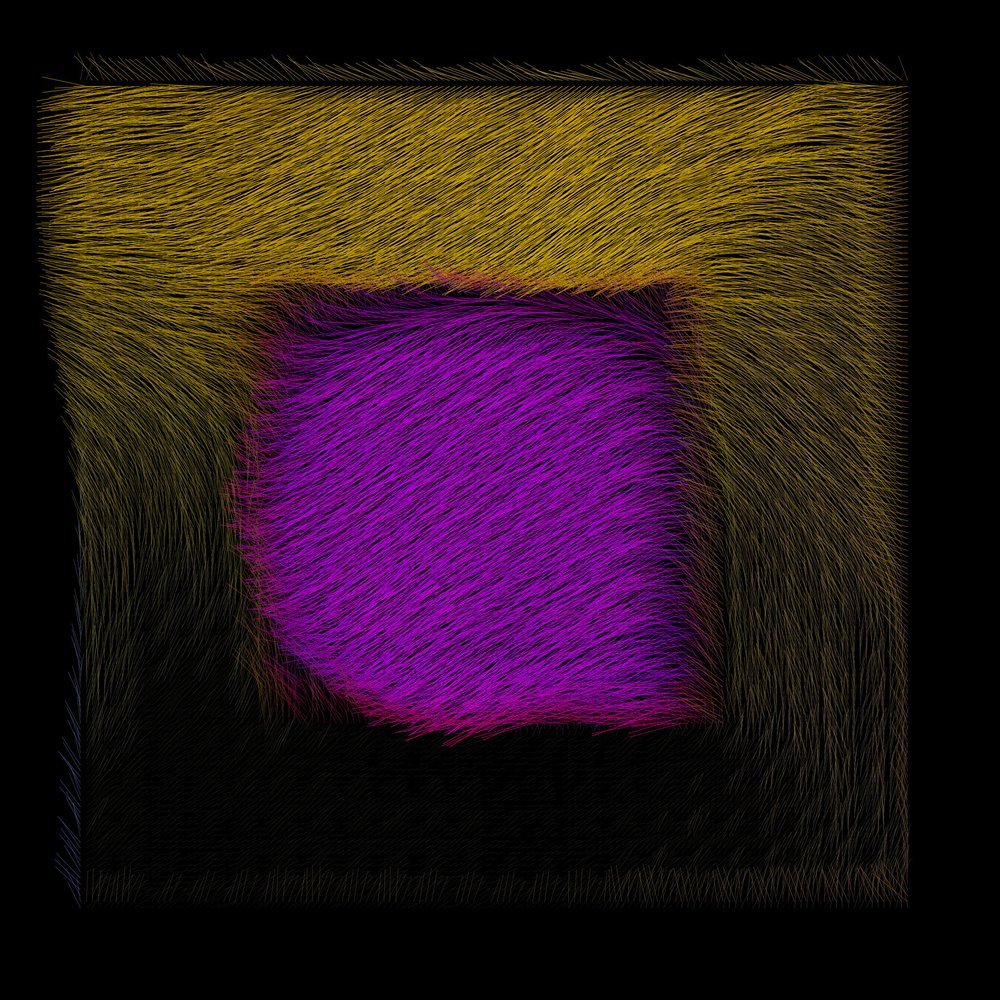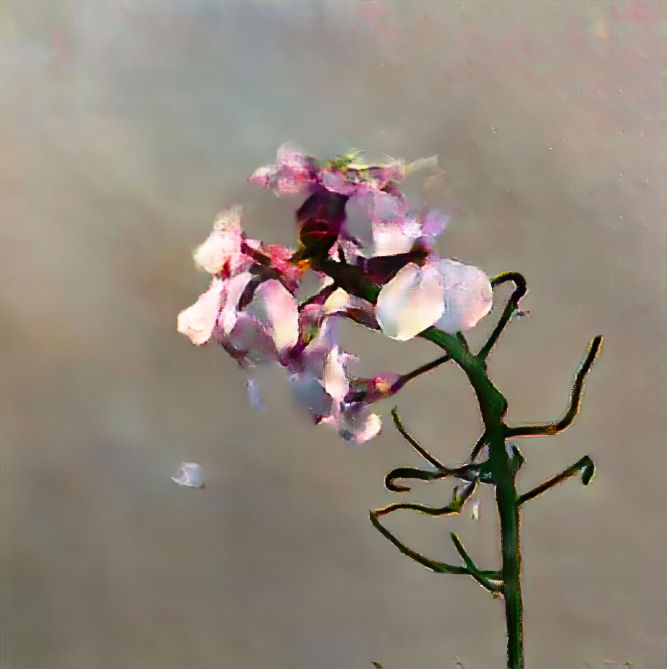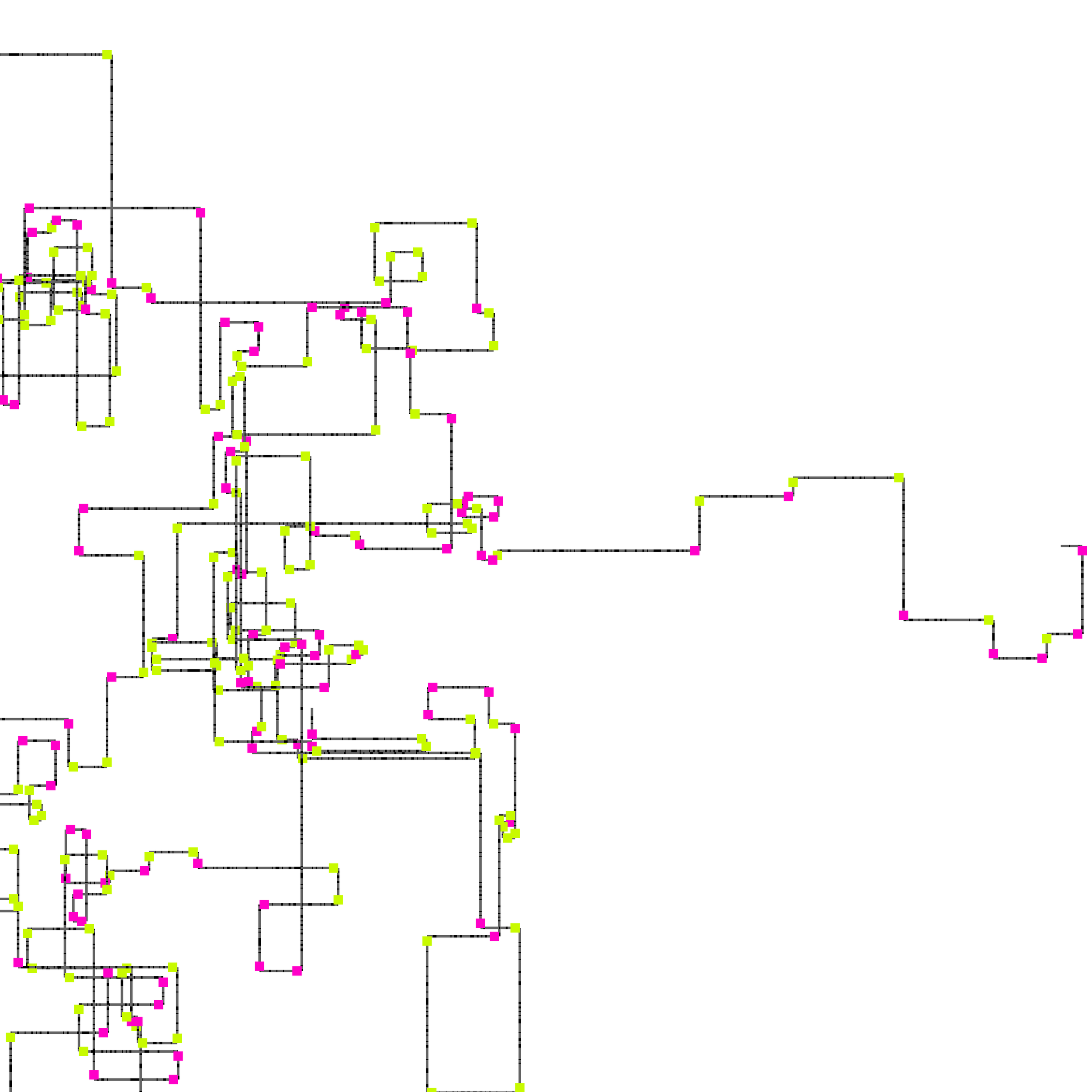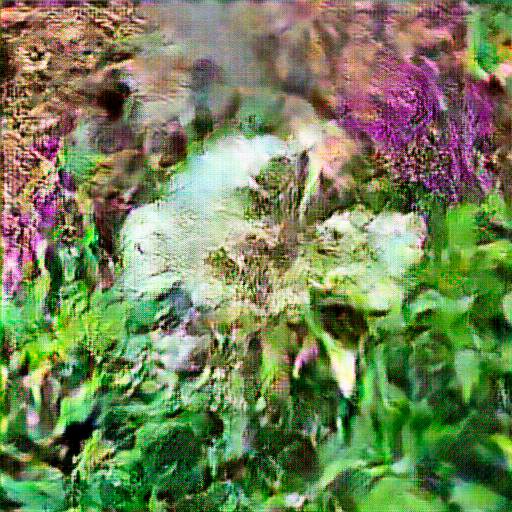Beyond Perception: The Art of David Young
David Young, an artist and designer based in New York, explores the interplay between art, and cutting-edge technologies such as artificial intelligence and quantum computing. His work is an exploration of technology and an inquiry into how these tools can reshape our understanding of beauty and offer insights into their workings. In this article, we will focus on his art from 2017 to the present and feature an exclusive interview with David Young himself. He shares the creative process behind his work, as well as discusses his past and his latest series, such as “Hallucinations”, which debuted this January at NOISE Media Art Fair at Kate Vass Galerie’s booth.
David Young's work highlights the complexities and common misconceptions associated with artificial intelligence and machine learning. Recognizing the need for a deeper understanding of AI, he seeks to demystify its potential applications, striving to develop a fresh interpretation of its capabilities and methods. He believes that beauty and aesthetic experiences can bridge the gap to a more open-minded understanding, helping individuals to reevaluate and deepen their insights into AI's learning mechanisms.
At the core of his practice and a central element in his artwork is the theme of perception. By examining the outputs generated by neural networks, he aims to provide insight into the machine’s learning process, how it learns and behaves, which is different from human perception. Through creating art, Young explores AI's unique 'way of seeing' the world, making the technology's complex processes more accessible and understandable. His work with quantum computing has followed a similar path, aiming to uncover new perspectives of the technology.
Young's journey into the intersection of art and tech began after completing his bachelor’s degree in computer science from the University of California and a master’s in visual studies from the Media Lab at the Massachusetts Institute of Technology. Initially focusing on design, he began to incorporate AI into his practice around 2016.
David Young: “Although I have been working with AI off and on since the 1980s, I seriously turned my attention to it in 2016. At that time advances in AI -- things like IBM's Watson and Google's DeepDream -- were capturing the public's imagination, and there was a general sense that AI was about to be the next big thing. But it was all still rather abstract, nobody really knew what AI might become, other than sense it was going to be disruptive.
I created a course called "Designing AI," at Parsons School of Design in New York, where I brought together non-technical students from a wide range of backgrounds to see if we could develop a more approachable way to talk about AI. I wanted to find a way to allow more diverse voices to think about what this new technology might be used for. The class was focused on bottom-up, or grassroots, change -- because I didn't have faith that tech companies were going to open themselves up, to bring outside voices in.
The course inspired a change in me, too. I realized that if I wanted to make my voice heard in what AI could become, it wasn't going to be by working inside a large company. Instead, I adopted a bottom-up philosophy and took the ideas from the class a step further -- instead of finding non-technical languages to make AI more approachable, I embraced the idea of beauty and aesthetic experiences. Something non-verbal that could make AI more approachable.”
FINDING BEAUTY
Between 2018 and 2020, he created a series of works where he emphasized beauty and aesthetics over the corporate values of optimization, efficiency, and consumption. In contrast to the vast sea of data, usually necessary for AI, Young contemplated the idea of beginning on a smaller, more personal level, directly engaging with the technology.
D.Y.: “Modern machine learning systems work because they're trained on vast quantities of data. But that size makes the technology unapproachable -- it's a scale that's hard to imagine. I thought that training the machine using small data sets, in my case sometimes just a handful of images, could give some insights into how the technology worked. I wanted to bring things back to a human-scale, so that we might develop intuitions for what was going on inside the code. And, in doing so, take some power back from the big tech companies.”
In his exploration, he produced many collections with a limited number of photos he personally took. These series include "Winter Woods" (2018-2020), depicting snowy woods; "Bovina, NY" (2018-2019), reflecting the tranquility of upstate New York; "Cloud Canyon" (2019), inspired by the hills of Griffith Park, Los Angeles; "Dandelions" (2020), where he captured the delicate beauty and fragility of the flower; and the well-known "Learning Nature", showcasing other type of flowers (exhibited at Kate Vass Galerie's historical show "Automat und Mensch", 2019). The common thread in each series is the utilization of subjects from nature.
To create the "Learning Nature" series, the artist employs GANs (Generative Adversarial Networks), a type of AI machine learning technology and he trains the model using his own photographs of flowers. By choosing to photograph subjects on his farm in upstate New York, in Bovina, he intentionally selects these themes to differentiate his work from conventional AI applications and to connect with the region's rich artistic heritage.
D.Y.: “I chose nature to emphasize the difference from mainstream AI, which prioritized business outcomes, and the optimization of scale, power, and greed.
I also chose nature because of where I live, in rural upstate New York. It's an area with a rich cultural history. Almost two hundred years ago the Hudson River School used painting to express man’s relationship to nature. I wanted to explore what would it mean for an AI, today, to understand and interpret that same nature.”
He was surprised to see how the AI's learning process mirrored human creativity when he used this data to train the model, experimenting through repetition and struggling at some points. However, the system lacks the capacity for the nuanced understanding needed to complete these fine details. What emerged wasn’t accurate but represented a machine's unique interpretation of the natural world.
The creation of art that does not strictly adhere to accuracy has a long history. Artists from the Dutch Masters to the Hudson River School incorporated elements from various scenes or included multiple natural elements to compose their final images. These images depict something that doesn't exist in the real world but capture their interpretation of the subject.
D.Y.: “As I worked I began to see a connection to 17th and 18th Dutch flower paintings. In those works, there were arrangements that could have never existed -- because the flowers shown would never have been in bloom at the same time. The images generated by my AI had a similarity impossibility, of merged and impossible flowers.”
BIASES OF AI
In 2019, with the "Tabula Rasa" series, Young explored further the learning mechanisms of machine learning systems and their inherent biases. Despite AI has been around since the 1950s, the artist questioned whether we can fully comprehend its behaviour.
The series, “Tabula Rasa” draws parallels to philosopher John Locke's idea that human knowledge comes through experience. Locke believed that the mind starts as a "tabula rasa" or blank slate, with knowledge and ideas coming from sensation and reflection. Similarly, Young thinks that AI systems begin with no inherent knowledge and learn through data input—their “sensation”—upon which they “reflect”. However, this data often consists of human biases, reflecting the preconceptions, irrationalities, and emotions of its collectors. This presents a question: if the foundational data is biased, can a machine's rationality be anything but an illusion?
To answer this question, he wanted to create works that minimize bias by using solid colors as the initial training material. He began with a single black image, allowing the machine to learn from this "blank" state. As he introduced a second color, the AI began to reveal its “emotions” and show more complex, almost stress-like behaviours, generating images with new textures, organic shapes, and overlapping grids.
D.Y.: “Tabula Rasa" began as a thought experiment, to see if approaching AI from a radically different perspective might give new insights into how it worked. When I started training the machine on two colors, for example, I thought that it would pretty quickly settle and just create images that were one or the other of the two colors. But instead, these strange patterns emerged. You could see the digital in them -- repeating elements, grid-like textures. But there was also something organic -- strange shapes, curves, blobs. And new colors would appear, colors that weren't in the training data. To me, I felt a tension in the machine as if it were struggling to make sense of what it had been shown. Of course this can be explained technically, but that wasn't what I was looking for. I wanted to find emotional, non-technical, ways to think about AI. I know that the AI is just code running on the machine, but there was a sadness to its struggle. It's very strange to attribute an emotion to something mechanical, but that's what art can do.”
The resulting works draw comparisons to abstract expressionism, especially to works created by artists such as Kenneth Noland, Mark Rothko, and Alberto Burri. This similarity was noted by Artnome, who connected the works to Carl Jung's psychology, specifically the idea of a "collective unconscious" filled with shared archetypes and visual symbols – the opposite interpretation of John Locke's concept. Artnome's observation raises the question of whether machine learning models might possess their own form of a collective unconscious, potentially including archetypes and symbols similar to those in the human psyche.
At the bottom: (b62g,5348), (b67m,1397,1), and (b67h2,2599,1) from Tabula Rasa series by David Young, At the top: Paintings by Kenneth Noland, Agnes Martin and Alberto Burri
D.Y.: “I was drawn to Locke's idea of the blank mind, the "tabula rasa," as that seemed most like what was happening as a neural network was trained. But the strange tensions that appeared in the resulting images had an emotional quality that recalled romanticism -- which itself was a reaction to the Industrial Revolution. Might modern AI somehow create work that is in reaction to its underlying technology, its own self?
The question about collective unconscious speaks to whether an AI system can ever achieve consciousness. And if so, what is "mind." If consciousness is emergent, meaning that it is a material trait or function of the brain, then I'd argue there can be no collective unconscious. Just like an AI, the brain starts as a tabula rasa.
However, if mind is something else, as in the case of mind-body dualism, where the mind exists separate from the body, then collective unconsciousness becomes a possibility. It's a topic that's becoming increasingly important as we talk about AI and AGI. And, interestingly, quantum physics suggests that this dualism might exist. In which case mind might be stranger than we can imagine.
Whatever the case, it's a rich area to explore -- computationally, philosophically, and artistically.”
DIGITAL THREADS
Young continued his investigations into machine learning in 2020. He began to further process the images generated by AI with his own coding to uncover patterns not immediately visible, aiming to understand their behaviour. His series "Manipulations" (2020) exposes what may be apparent to the learning mechanism but obscured to human observers. He questions what hidden patterns or "irrational logic" might exist within the AI's creations. During this exploration, his artworks began to show textile-like qualities, with strands finely rendered to mimic the look of densely packed fibers or threads. These qualities continued into his later series, such as the "Flag" (2022) series, where he employed the same machine learning techniques and output manipulations to explore themes of democracy, gun violence, and abortion.
Between 2020 and 2022, the artist started to experiment with training the model with actual images of textiles, building upon the textile-like features already evident in his previous series. In the work “Darns” (2020 – 2022), in collaboration with textile artist Susan Yelavich, he investigated the AI's interpretation of Yelavich’s textile works. By selecting and manipulating the learning process, Young examines the machine's partial understanding and highlights the system's imperfect “vision”. Based on these generative images, Yelavich then created physical textile works, stitching the manipulated images to reveal hidden elements and bridge gaps in the model’s learning.
EXPLORING QUANTUM COMPUTER
Young's artistic inquiry extended beyond AI and machine learning to explore the field of quantum computing in 2021, focusing on understanding how this technology works. His interest was piqued by the extraordinary nature of quantum mechanics, which defies the speed of light, potentially presenting a paradigm shift in computational thinking.
He began the project using quantum computers from IBM Quantum to produce outputs that were then processed through his custom code. After multiple iterations of his coding, Young began to find new ways of interpreting the data, aiming to grasp a sense of the underlying quantum phenomena.
D.Y.: “Like AI, quantum computing is an emerging technology that is said to be the next big thing -- the next inevitable technological progression. I started working with it around the time of the NFT boom because all of these things -- AI, NFTs, quantum -- to me, reflected a cultural obsession with the "new," and how these technologies will all eventually become obsolete. In particular, quantum had the potential to almost instantaneously crack the security that is the core of the blockchain and NFTs. So I thought it was an interesting contrast, or tension, between the two.
When I first started working with IBM quantum computers I used code that I found online -- just as I did with AI -- because, again, I wanted to emphasize that technical proficiency should not be a requirement for engaging with new tech. I also did that because quantum is weird. I mean, AI is weird, too. But quantum is a whole other level of weirdness.
And so, once I got some code to run, I took the output data and worked on ways to give it visual form. At first my "Quantum Drawings" were lines, tracing whether the quantum-bit values were correct computations or noise. But as I learned more about quantum -- not just quantum computing, but quantum physics -- I began to see in the data quantum themes such as how, when I examine the value of a quantum bit the universe splits, which is how we have the multiverse. And so the work shifted to a more expressive exploration of what a quantum universe means. It's moved the work from a technological critique to something more philosophical.”
HALLUCINATIONS
At the bottom: ‘People Are Begging to Be Disappointed’ and ‘Mitigating the Risk of Extinction’ from Hallucinations series by David Young. At the top: Paintings by Luigi Russolo and Giacomo Balla
In his latest series from 2023, “Hallucinations” the artist returned to experiment with AI and machine learning, using these technologies to explore the parallels between their promised potential and actual errors, known as "hallucinations". This body of work, which debuted at the Kate Vass Galerie booth at the NOISE Media Art Fair in Istanbul in 2024, reflects on the tech industry's hype and the reality of AI capabilities, drawing titles from quotes by tech leaders such as Sam Altman, the CEO of OpenAI.
Similar to his earlier works, he used GANs and trained them with limited training data, prompting the AI to generate less coherent visuals. The artworks feature grids of disconnected pixels manipulated by his custom software, revealing structures and patterns not originally visible.
From an art historical perspective, the lines and dynamism in his work share similarities with Futurism, an early 20th-century movement that celebrated the promises and dynamism of technology. The Futurists emphasized speed, movement, and industrial development, often depicted through bold lines and a sense of motion. However, while Futurism glorified the future and technology, Young's series presents a more critical narrative, questioning the compatibility of AI's actual functionalities with the industry's grand promises.
D.Y.: “There is so much hype around AI right now that we're distracted from the problems of this technology -- its perpetuation of bias and its optimization of existing inequalities. "Hallucinations" is a term -- what I'd call anthropomorphic mysticism -- that distracts us from the fact that the strange outputs from AI systems are nothing more than errors. They reveal the flaws inherent in the technology.
At the same time, the tech industry has outsized beliefs of self-importance, and that AI is going to change the course of humanity. They, too, are hallucinating -- caught up in their own hype. This is why the titles of these works are quotes from tech industry leaders talking about AI.
So my "Hallucination" works are an expression of my frustration with this state of things. I want to highlight that AI isn't perfect, or even, necessarily, inevitable.”
BIBLIOGRAPHY:
David Young, Designing AI, 2016: https://medium.com/designing-ai/designing-a-i-4d19bbd0c317
David Young, Little AI, 2018: https://medium.com/@dkyy/little-ai-298fcba0832d
David Young, Tabula Rasa, 2019: https://medium.com/@dkyy/tabula-rasa-b5f846e60859
Artnome, Tabula Rasa - Rethinking The Intelligence Of Machine Minds, 2019: https://www.artnome.com/news/2019/9/17/tabula-rasa-rethinking-the-intelligence-of-machine-minds
Lindsay Comstock, Pondering the Liminal Space of AI in Art, 2020: https://davidyoung.art/blog/liminal.html
Lindsay Comstock, Translations with Code and Thread, 2022: https://davidyoung.art/blog/echo-chambers.html







































